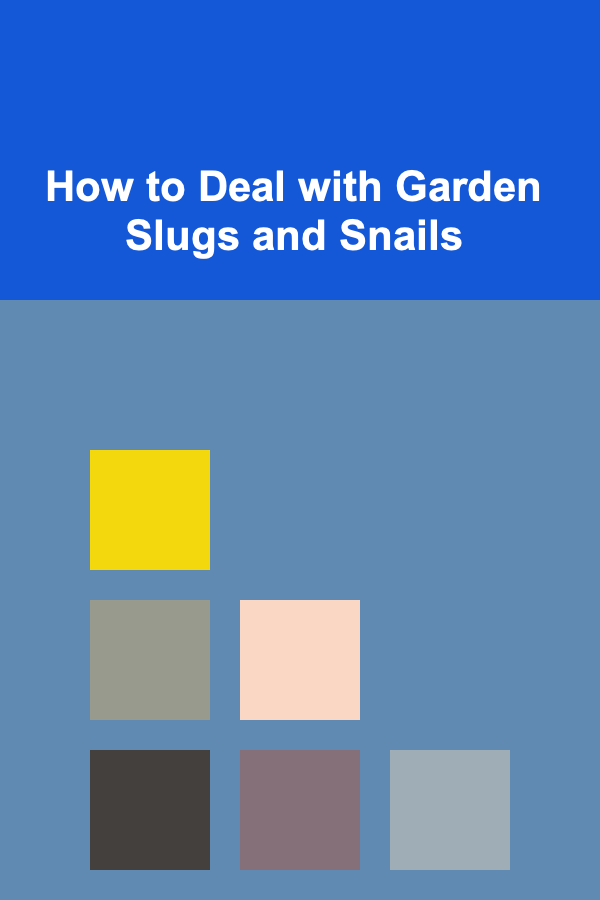
How to Deal with Garden Slugs and Snails
ebook include PDF & Audio bundle (Micro Guide)
$12.99$7.99
Limited Time Offer! Order within the next:

Gardens, whether small backyard spaces or expansive landscapes, often become home to a variety of wildlife. While many creatures contribute to the beauty and biodiversity of gardens, others can be pests that cause significant damage to plants. Among the most notorious garden pests are slugs and snails. These creatures are slow-moving but relentless in their ability to devour plant life, leaving behind unsightly holes and even killing entire plants. Despite their destructive tendencies, slugs and snails can be managed effectively through various methods, both natural and chemical.
This article explores the behaviors of slugs and snails, the damage they cause, and offers detailed, effective strategies to deal with them in your garden.
Understanding Slugs and Snails
Slugs and snails belong to the same family of gastropods, with snails being distinguished by their characteristic spiral shells and slugs lacking shells altogether. Both types of mollusks thrive in moist, humid environments, making gardens and outdoor spaces ideal places for them to flourish.
Biology and Behavior
Slugs and snails are nocturnal creatures, meaning they are most active at night or during rainy weather. This behavior allows them to avoid the heat of the day, which can desiccate their soft bodies. They feed primarily on plant material, including leaves, stems, and roots. While their diet often includes decomposing organic matter, they tend to favor tender, young plants that are most susceptible to damage.
Slugs and snails move by secreting a slimy mucus trail, which helps them glide over surfaces and reduces friction. This mucus also serves as a protective barrier to prevent their bodies from drying out. They have a simple nervous system but are remarkably effective at locating food sources through chemical trails and tactile sensations.
Damage Caused by Slugs and Snails
The damage caused by slugs and snails in gardens can be both frustrating and economically significant for growers. Here are some of the primary ways in which these pests cause harm:
- Feeding Damage: Slugs and snails create irregular holes in plant leaves, often leaving a silvery, slimy trail behind. This can lead to defoliation, particularly in young plants or seedlings.
- Root Damage: Some species of slugs feed on plant roots, which can hinder growth and even kill plants if the root system is severely damaged.
- Disease Transmission: Slugs and snails can carry and spread diseases such as the nematodes that infect plant roots, contributing to further plant stress and damage.
- Aesthetic Damage: Slime trails left on plant surfaces, as well as large holes in leaves, are unsightly and reduce the aesthetic appeal of the garden.
Natural Methods to Control Slugs and Snails
Before resorting to harsh chemicals, gardeners should consider natural and environmentally friendly methods to control slugs and snails. These strategies can be effective without harming beneficial insects, pollinators, or the ecosystem at large.
1. Hand-Picking and Trapping
One of the most basic, yet effective, ways to manage slugs and snails is by physically removing them from your garden. This can be done by hand-picking the pests during the evening when they are most active. The best time to do this is right after a rainfall or during a humid night when slugs and snails are more likely to emerge.
How to Hand-Pick Slugs and Snails:
- Use gloves to handle the slugs and snails to avoid leaving behind any human scent, which can deter other pests.
- Place the collected slugs and snails in a bucket of soapy water to dispose of them humanely.
For those who don't want to touch the creatures directly, there are also slug and snail traps available in stores. These traps often use beer or other attractants to lure the pests into a container where they can be trapped and removed.
2. Creating Barriers
Slugs and snails are not fond of moving over rough or sharp surfaces, and you can use this to your advantage by creating barriers around your plants. These barriers can either deter them from crossing or cause them to get stuck.
Effective Barriers Include:
- Copper Tape: When placed around the edges of garden beds, pots, or individual plants, copper tape can create a mild electrical shock when slugs or snails come into contact with it. This discourages them from crossing the tape and reaching the plants.
- Sharp Materials: Crushed eggshells, diatomaceous earth, or even crushed gravel can be spread around plants to deter slugs and snails. These materials are abrasive to the pests' soft bodies and can prevent them from moving across the area.
- Sand and Ash: Some gardeners use wood ash or sand to create a dry, gritty surface around plants. While not as effective as copper tape, these substances can still reduce slug and snail activity by irritating their bodies.
3. Encouraging Natural Predators
Another natural method for dealing with slugs and snails is by introducing or encouraging the presence of natural predators. Many animals feed on slugs and snails and can help keep their population in check.
- Birds: Various species of birds, such as thrushes and crows, are natural predators of slugs and snails. By encouraging birds to visit your garden, you can reduce the population of these pests. Installing birdhouses or bird feeders can attract more birds to your garden.
- Frogs and Toads: These amphibians also love to eat slugs and snails. Keeping a pond or a water feature in your garden can attract these helpful creatures, leading to a more balanced ecosystem.
- Ground Beetles: Ground beetles are another natural predator that feeds on slugs and snails. Their presence in the garden can significantly reduce pest numbers. You can encourage ground beetles by providing hiding places, such as mulch or compost piles.
4. Organic Slug Repellents
There are a variety of organic slug repellents that can be used to deter pests from attacking your plants. These include both homemade and commercially available products that can be applied directly to plants or the soil.
Common Organic Slug Repellents:
- Garlic and Chili Spray: Slugs and snails are repelled by the strong odor of garlic and the heat of chili peppers. You can make a simple repellent by blending garlic and chili peppers with water and spraying it around your garden.
- Nettle Tea: Nettle tea is known for its strong smell, which slugs and snails dislike. By spraying this tea around vulnerable plants, you can help keep the pests at bay.
- Coffee Grounds: Used coffee grounds are said to repel slugs and snails, likely due to their caffeine content. Sprinkling coffee grounds around plants may deter the pests from approaching.
5. Crop Rotation and Companion Planting
Crop rotation is an essential gardening practice for managing pests, including slugs and snails. By rotating your crops every season, you disrupt the lifecycle of pests that are specific to certain plants. This can help reduce the likelihood of slug and snail infestations.
Companion planting involves growing certain plants that are known to repel slugs and snails near more vulnerable plants. For example, planting garlic, chives, or rosemary alongside your crops can act as a natural deterrent to slugs and snails.
Chemical Methods to Control Slugs and Snails
While natural methods are often preferred, there may be times when chemical solutions are necessary, particularly in severe infestations. It's important to use these chemicals carefully to avoid harming other creatures in your garden or polluting the environment.
1. Slug Pellets
Slug pellets are one of the most common chemical treatments for slug and snail problems. These pellets contain toxic substances that attract slugs and snails and kill them when consumed. While effective, slug pellets must be used with caution.
- Iron Phosphate-Based Pellets: These are less toxic to pets and wildlife and are a more environmentally friendly option than traditional metaldehyde-based pellets. Iron phosphate disrupts the digestive system of slugs and snails, causing them to stop feeding and eventually die.
- Metaldehyde-Based Pellets: These pellets are more toxic and should be used with extreme caution. They can be harmful to pets, wildlife, and children, so care must be taken to ensure they are placed in areas that are out of reach.
2. Chemical Sprays
Some chemical sprays are available to kill slugs and snails upon contact. These products typically contain copper or other active ingredients that disrupt the pests' physiology. These sprays should be applied directly to plants or affected areas, and users should follow the instructions carefully to minimize environmental harm.
Preventative Measures
In addition to active control measures, there are several preventative steps gardeners can take to reduce the likelihood of slug and snail infestations in the future:
- Maintain a Clean Garden: Slugs and snails are attracted to damp, cluttered areas where they can hide during the day. Regularly removing weeds, debris, and fallen leaves from your garden can help reduce the available hiding places for these pests.
- Watering Practices: Watering your garden in the morning, rather than the evening, helps to dry out the soil before nightfall. Slugs and snails are nocturnal, and this practice can make it less likely that they will be able to feed and thrive.
- Mulching with Care: While mulch can help retain moisture for plants, it can also provide ideal conditions for slugs and snails. If using mulch, consider using coarse materials like pine needles or straw, which slugs find less hospitable.
Conclusion
Slugs and snails are persistent pests that can damage plants and disrupt garden aesthetics. However, with the right approach, gardeners can effectively control and prevent these creatures from becoming a serious problem. By employing a combination of natural methods, including hand-picking, creating barriers, and encouraging natural predators, as well as using organic repellents and chemical solutions when necessary, you can safeguard your garden from these slow-moving pests.
With a proactive and balanced approach, you can ensure your garden remains healthy, vibrant, and free from the ravages of slugs and snails.
Reading More From Our Other Websites
- [Organization Tip 101] How to Fix a Leaky Roof Before It Becomes a Major Problem
- [Needle Felting Tip 101] How to Create Realistic Miniature Wildlife Sculptures with Needle Felting
- [Personal Investment 101] How to Build a Balanced Investment Portfolio with ETFs
- [Home Storage Solution 101] How to Create a Home Office Storage System for Productivity
- [Home Budget Decorating 101] How to Find Discount Furniture and Decor Online
- [Personal Care Tips 101] How to Use Face Oil to Achieve Glowing Skin
- [Rock Climbing Tip 101] Underrated Gems: Lesser-Known Climbing Documentaries You Need to See
- [Home Holiday Decoration 101] How to Make Gingerbread House Decorating a Fun Tradition for Your Family
- [Home Holiday Decoration 101] How to Decorate a Christmas Tree Like a Pro: Tips for a Stunning Holiday Display
- [Organization Tip 101] How to Use Bins and Containers to Store Hobby Supplies
How to Create a Checklist for Tracking Book Club Progress
Read More
How to Make a Checklist for Researching Neighborhoods
Read More
How to Organize Your Closet for Easy Access
Read More
How to Style Your Holiday Mantel for Maximum Impact
Read More
How to Use Video Analysis to Improve Student Performance
Read More
How to Navigate Life Insurance Options for People with Pre-Existing Conditions
Read MoreOther Products
How to Create a Checklist for Tracking Book Club Progress
Read More
How to Make a Checklist for Researching Neighborhoods
Read More
How to Organize Your Closet for Easy Access
Read More
How to Style Your Holiday Mantel for Maximum Impact
Read More
How to Use Video Analysis to Improve Student Performance
Read More